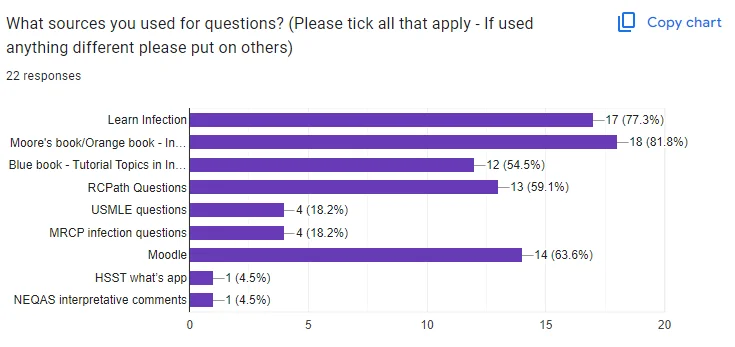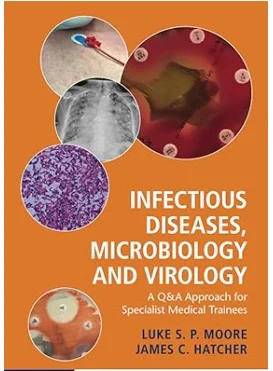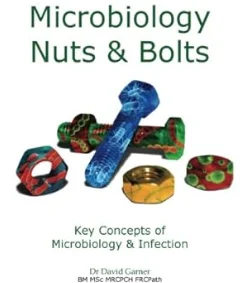This is a common question for anyone intending to sit part 1. What are the resources you should use? This page is based on my experience and that of many other microbiologists I have worked with before.
This is a huge list, and your question will be, "Do I need to read it all?"
Unfortunately, I cannot answer that. Questions came from all these areas, but you need to balance your background knowledge and how much time you have. Find an idea from the survey I posted. As a minimum -
- Oxford Handbook (must read)
- Orange book (must read)
- Learn-infection is a must-read.
- SMI and EUCAST - very important.
- Any recent guidelines, especially NICE guidelines, are a must.
- Moodlecloud Questions, high yield notes and core modules- I cannot say it is a must-read as this is my own project - you should ask other candidates and decide for yourself.
This should cover a large area, but still there will be questions that may come from areas outside this list, for example, statistics. Hence, you should check the list below:
Books
How popular are these books amongst those who sat part 1?

Some examinees prefer conventional textbooks. I do not consider these books essential, but you can use one of them if you wish. You can choose any of the following, but I suggest using one recently published most recently.
Infection control and statistics:
Apart from these books, you must prepare for infection control and statistics. You can prepare infection control using various documents available on the internet. However, if you are looking for a book to find all the basics of infection control, I recommend - Manual of Infection Prevention and Control by Dr Nizam Damani.
For statistics, choose a book that you find best. My suggestion, based on what examinees used - How to Read a Paper: The Basics of Evidence-based Medicine and Healthcare, 6th Edition OR, Oxford Handbook of Medical Statistics
Where to find questions?
Here is the result of a survey. See what people used to find questions -

1. Books
The two books mentioned above are popular choices for questions as well.
- Infectious Diseases, Microbiology and Virology: A Q&A Approach for Specialist Medical Trainees
- Tutorial Topics in Infection for the Combined Infection Training Programme
2. BIA LearnInfection:
However, you must use BIA LearnInfection - this is an invaluable asset and practice all the questions in there. You can find it here, and you will need a BIA membership to access it here: https://learn.britishinfection.org/
3. Royal College past papers:
Find the past papers from RCPath here -
- https://www.rcpath.org/trainees/examinations/examinations-by-specialty/medical-microbiology.html
- https://www.rcpath.org/trainees/examinations/examinations-by-specialty/infection.html
4. MRCP and USMLE questions
There are many books and online resources for these two exams, and you can consider solving these papers. However, remember that these exams are aimed at different populations, and the standards are different. This is especially true for USMLE as the problems are often different and the guidelines they follow are not necessarily UK guidelines.
5. NEQAS interpretative comment
This is an external quality control method for microbiologists. This is membership-based. Members get 1 case and approximately 2 - 4 questions every month. It may cost approx £100/year. If you already have a membership for another reason, it is great; however, it might be an expensive way of solving questions.
Interpretive Comments - UK NEQAS Microbiology
6. Microregistrar.moodlecloud.com
Find more information here - Home | microregistrar
Is there any course?
This is an exam which lacks courses to help. Our survey says -


So what are the options?
1. RCPath International Trainee Support Scheme
The International Trainee Support Scheme is an online-based scheme that is aimed at supporting overseas doctors (also known as ‘International Medical Graduates’) who are planning to sit the College’s fellowship examinations. I have heard good feedback about this course, but it is not always available. It cost around £400- £500. You have to contact RCPath directly if it is still available - International Trainee Support Scheme
2. Courses run by independent NHS Consultants or clinical scientists
There are some courses run by NHS consultants or clinical scientists virtually. I have not attended these courses; hence, I cannot give you any recommendations either way. You can enquire about these courses on WhatsApp groups. The cost of these courses may vary, but as far as I know, it is approx £200 - £600
3. Local courses
Local microbiologists and departments run these courses and are often not available to outside candidates, or you may have to travel to attend. You can find information by asking your seniors or using WhatsApp.
4. Other courses not directly related to the exam
Some courses may help in general but are not necessarily aimed towards FRCPath Microbiology - Foundation Certificate in Infection Prevention and Control - Healthcare Infection Society. These courses are excellent, but this may only cover part of your curriculum (like infection control), hence may or may not solve your purpose.
5. Microregistrar.moodlecloud.com
This is not a conventional short course. This will provide you with reading material written keeping UK practice in mind and practice questions keeping the FRCPath exam in mind. You will also have high-yield notes and a WhatsApp group to discuss your questions. You will be supported by me and a group of people who
What other resources should I use?
What does our survey say?

1. UK SMI
These are the UK national standard operating procedures; as you can see from the survey, they are very important.
Link - UK Standards for Microbiology Investigations
2. NICE guidelines
Published guidance, NICE advice and quality standards | Guidance | NICE
3. Greenbook (vaccine)
Immunisation against infectious disease - GOV.UK
4. EUCAST
For antibiotic sensitivity, follow EUCAST (not CLSI). Important documents (must read) are -
- eucast: Clinical breakpoints and dosing of antibiotics
- eucast: Expert rules and expected phenotypes
- eucast: Resistance mechanisms
- eucast: S, I and R definitions
- eucast: MIC and zone distributions and ECOFFs
5. Other UK guidelines
A large number of British organisations are involved in preparing guidelines. I have listed some. If there is no UK guideline on a subject, follow European (ESCMID) or IDSA/CDC/SHEA guidelines. Some of these are not specific for infection, such as RCOG. You may have to collect those relevant for you yourself.
- Published and Reference Guidance | British Infection Association (BIA)
- Guidelines and guidance by topic - Healthcare Infection Society
- Current Guidelines
- Guidelines | BASHH
- Green-top Guidelines | RCOG
- Gastroenterology and Endoscopy Guidelines | BSG
- Guidelines | British Thoracic Society | Better lung health for all
- SaBTO - ODT Clinical - NHS Blood and Transplant
- SaBTO microbiological safety guidelines - GOV.UK
- SaBTO reports and guidance documents - GOV.UK
- Guidelines & Standards - British Transplantation Society
- BOA Standards for Trauma and Orthopaedics (BOASts)
- Creutzfeldt-Jakob disease (CJD): guidance, data and analysis - GOV.UK
- NHS England » Health technical memoranda
- UK CVN guidelines – http://www.clinicalvirology.org/guidelines/
- British Society of Rheumatology – https://www.rheumatology.org.uk/practice-quality/guidelines
- British Society of Haematology – https://b-s-h.org.uk/guidelines/
- Guidelines.co.uk – https://www.guidelines.co.uk/
- Viral rash in pregnancy - GOV.UK
6. UKHSA documents
UKHSA is a massive resource for microbiologists/infection specialists. It is also the most up-to-date resource. It is, however, so vast that it is not always easy to find what you are looking for. I suggest you start from the A to Z link I shared, but always when reading a subject - google "your subject name" + "UKHSA".
7. UK antibiotic guidelines
If you are from overseas, you can benefit from having UK antibiotic guidelines. I suggest looking at the NHS Trust guidelines using Microguide or EOLAS
- Leeds Formulary Formulary
- Summary of antimicrobial guidance: Summary of antimicrobial prescribing guidance - managing common infections | RCGP Learning
8. BNF and Greenbook
BNF lists all the antibiotics being used in the UK. Reading antibiotics that are not in there is not needed unless they are new/novel antibiotics. BNF also has a comprehensive summary of antibiotics. Greenbook is the one-stop resource for vaccines used in the UK.
Some other resources
Infection control
- epic3: National Evidence-Based Guidelines for Preventing Healthcare-Associated Infections in NHS Hospitals in England
- National Infection Prevention and Control Manual
Journals
Laboratory safety and quality
- ACDP - Search - GOV.UK
- https://www.hse.gov.uk/pubns/clinical-laboratories.pdf
- https://www.hse.gov.uk/biosafety/laboratories.htm
- https://www.hse.gov.uk/biosafety/management-containment-labs.pdf
- Quality manual – https://mft.nhs.uk/app/uploads/2021/02/Manchester-Quality-Manual.pdf
- Hospital safety – https://www.aintreehospital.nhs.uk/media/11602/ii-health-safety-policy-ii-gen-pol-2-v2.pdf.



